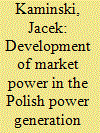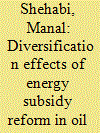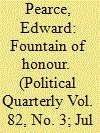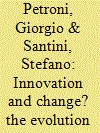|
|
|
Sort Order |
|
|
|
Items / Page
|
|
|
|
|
|
|
| Srl | Item |
| 1 |
ID:
111408


|
|
|
|
|
| Publication |
2012.
|
| Summary/Abstract |
The paper examines how and to which extent consolidation in the Polish power generation sector has affected the potential for market power over the last 10 years. Although this sector has been undergoing liberalisation (privatisation, introduction of TPA regulations and competition etc.), the consolidation efforts shown by Polish governments have resulted in a significant increase in concentration of both installed capacity and production. The methodology applied in this study includes typical ex-post structural and behavioural measures employed to estimate potential for market power, namely: concentration ratios (for the largest and the three largest suppliers), the Herfindahl-Hirschman Index, entropy, Supply Margin Assessment, the Residual Supply Index and the Lerner Index. Furthermore, an analysis based on the Gini coefficient was employed to obtain an insight into inequalities. The results of this study show that governmental decisions led to a significant increase in the potential to exercise market power held by key power generation companies. Of key importance was the 2007 consolidation, resulting in an increase in the HHI to 1374 (in terms of installed capacity) and 1945 (in terms of electricity production). This consolidation resulted in the creation of the first Pivotal Supplier in the Polish power generation sector in 2008.
|
|
|
|
|
|
|
|
|
|
|
|
|
|
|
|
| 2 |
ID:
171484


|
|
|
|
|
| Summary/Abstract |
For oil exporters, energy subsidy reform and economic diversification are critical policy responses to recent fundamental changes in the global oil market and oil price declines, yet the relationship between them is little understood. This article investigates linkages between energy subsidy reform and accelerating economic diversification away from hydrocarbons in a low oil price environment, using illustrations from Kuwait. It employs an economy-wide, general equilibrium model with oligopolistic industrial structure, the first of its kind for an economy in the Middle East and North Africa, that embodies unique elements of the country's economic structure—oil dependence; public sector dominance; subsidies; sovereign wealth funds; industrial collusive pricing behaviour; and guest workers. The article argues that, contrary to common popular discourse, Kuwait's economy has a diversified economic base, but this base fails to diversify export or government revenue needed for economic sustainability. Results show that weak economic diversification in oil exporters with a similar economic structure is not primarily due to “Dutch disease,” as dominant in the literature, but to economic constraints and distortions that impair structural change and exacerbate overdependence on hydrocarbons. Labour and competition reforms relax some constraints, achieving large efficiency gains that extend economy-wide and can expand non-energy tradable sectors. The analysis has important policy implications. First, the potential role of pricing regulation in small economies in moderating economic impacts of negative oil shocks. Second, in oil economies characterized by pervasive oligopolies, microeconomic reform can be a channel to achieve efficiency and better diversification effects of subsidy reform.
|
|
|
|
|
|
|
|
|
|
|
|
|
|
|
|
| 3 |
ID:
107212


|
|
|
|
|
| Publication |
2011.
|
| Summary/Abstract |
Pearce argues that honours do not deserve the earnest linguistic toil of the virtuous PAC. Starting with the peers, he observes that when William the Conqueror/Bastard distributed land stolen with violence to his armed band, it was the simple loot from which ancient chivalry, honour and nobility flows. Such lords developed under the more civilised early Whigs, like Walpole, into rent for sending steady support from owned boroughs into the Commons. Witness Bubb Dodington and his three and a half seats in Weymouth, made a Viscount in the name of one of its suburbs.
Harold Macmillan would sack a minister with the wheedling consolation 'A Little something to wear under your tie'. By inventing the Life Peerage, he helped the slow subversion of elected government by creating unelected, often powerful ministers with no relationship to country or people, candid nominees of the National Leader. The one virtue of the post-Macmillan upper house lies in the disloyal, which is say minimally or not all party-attached people of talent reliably voting against ministerial requirements. As for the insignia of all honours, their bars, discs and ribbons are kept on cards in Palace drawers like so much paste jewellery.
|
|
|
|
|
|
|
|
|
|
|
|
|
|
|
|
| 4 |
ID:
111260


|
|
|
|
|
| Publication |
2012.
|
| Summary/Abstract |
Since the 1980s a trend has emerged to contain the cost of space missions, which has favored trials in the construction and launch of small satellites. This effort has considerably reduced the cost of the satellites because the construction process uses both traditional components and important technological innovations. There have also been market openings for small satellites, both within the telecommunication sector and for scientific missions and those related to Earth observation. This paper contains the results of a survey of the largest manufacturers of small satellites in Europe and investigates how far (if at all) they have changed the structure of the European space industry. It finds that, through the acquisition of small satellite manufacturers, traditional large companies operating in the field of space in Europe have secured for themselves important technological innovations and market opportunities, while maintaining their oligopolistic position.
|
|
|
|
|
|
|
|
|
|
|
|
|
|
|
|
|
|
|
|
|